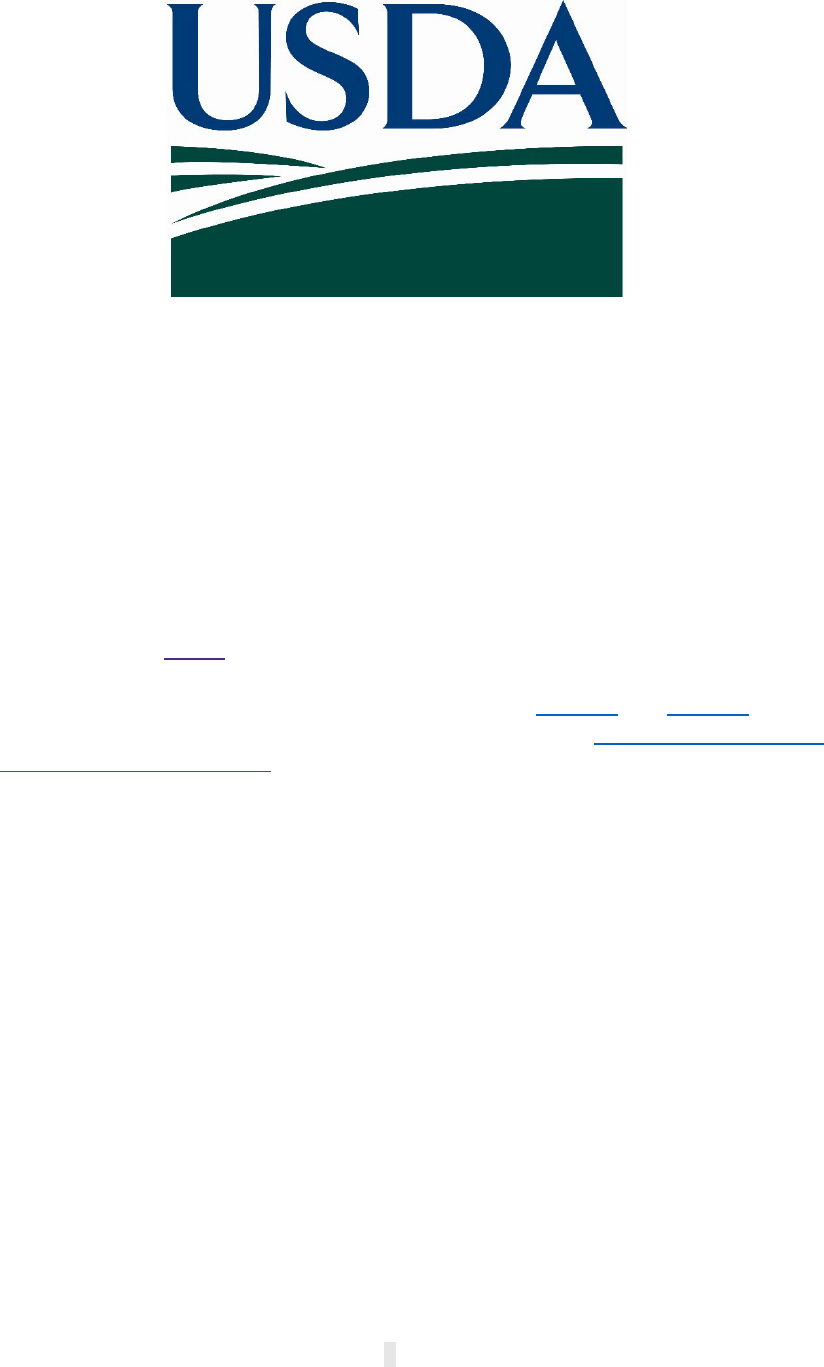
7/2023
COVID-19 Workplace Safety Plan
USDA’s mission is to provide critical services for curbing poverty and hunger, make credit
available for rural development (where approximately 20% of Americans live), stabilize or
improve domestic farm income, manage the integrity of critical natural resources, ensure the
quality of food supplies, develop markets for agricultural products and services, and sustain the
productivity of the Nation’s forests, grasslands, and natural resources. Accordingly, this USDA
Workplace Safety Plan was created in response to:
• Executive Order 13991, Protecting the Federal Workforce and Requiring Mask-Wearing
(January 20, 2021);
• Office of Management and Budget (OMB) Memoranda M-21-15 and M-21-25; and
• Safer Federal Workforce Task Force guidance, including the updated Model Agency
COVID-19 Safety Principles (September 15, 2022).
USDA created this Workplace Safety Plan (Plan) to guide how Mission Areas, Agencies, and
Staff Offices should implement COVID-19 safety protocols, consistent with guidance from the
Centers for Disease Control and Prevention (CDC). As we have done since the start of the
pandemic, USDA works to balance delivery of our critical missions with adapting to the everyday
challenges that COVID-19 may present to the workforce. The health and safety of the USDA
workforce, contractors, and the public is paramount. The Plan continues to be updated based on
evolving guidance from CDC, General Services Administration, the Office of Personnel
Management, and the Safer Federal Workforce Task Force (Task Force).
State, local, commonwealth, territorial, or Tribal governments, may provide guidance that differs
from this Plan, but this Plan establishes the baseline Federal requirement, regardless of such
guidance. Where a locality has imposed additional requirements related to COVID-19 that are
more protective than those set forth in these model safety principles, those requirements must be
followed in USDA facilities and on USDA land in that locality. USDA aims to be a partner in our
communities to stop the spread of COVID-19.
1

7/2023
Table of Contents
COVID-19 Coordination Team ................................................................................................... 3
COVID-19 Community Levels.................................................................................................... 3
Mask-Wearing............................................................................................................................. 3
Vaccination for Employees, Contractor Employees, and Visitors, and Safety Protocols for
Contractor Employees, Visitors, and Customers .................................................................... 5
Diagnostic Testing..................................................................................................................... 6
Travel for Official Business ....................................................................................................... 7
Symptom Screening .................................................................................................................. 9
Post-Exposure Precautions ...................................................................................................... 9
Isolation and Post-Isolation Precautions ............................................................................... 10
Meetings, Conferences, and Events ....................................................................................... 11
Workplace Operations ............................................................................................................. 11
Hygiene ..................................................................................................................................... 12
Leased and Shared Facilities .................................................................................................. 12
Collective Bargaining Obligations .......................................................................................... 12
Confidentiality and Privacy...................................................................................................... 13
APPENDIX A ............................................................................................................................. 14
2

7/2023
COVID-19 Coordination Team
USDA has an established COVID-19 Coordination Team. The team includes:
• Executive Leadership
• Public Health Experts
• Office of Human Resources Management
• Office of the General Counsel
• Representatives from Mission Areas and Staff Offices
The team meets to review agency COVID-19 workplace safety plans and protocols, consider
potential revisions to agency COVID-19 workplace safety plans and protocols pursuant to
guidance from the Task Force and the CDC, and evaluate any other operational needs related
to COVID-19 workplace safety. The team coordinates with the Office of Operations which
provides occupational safety and health for the National Capital Region, and the Office of
Property and Environmental Management which oversees facility management across USDA.
Through USDA’s monthly Labor Management Forum, the Coordination Team engages regularly
with USDA’s national unions. The team also consults with USDA’s Senior Agency Official for
Privacy, as needed.
COVID-19 Hospital Admission Levels
The CDC has set recommendations related to COVID-19 by County | CDC
, which measure the
impact of COVID-19 illness on health and healthcare systems. COVID-19 hospital admission levels
are identified for each county. For each USDA facility, USDA uses the COVID-19 hospital
admission levels in the county where the facility is located to determine the appropriate
prevention strategies to utilize at a given time, including as it relates to mask-wearing. There are
three COVID-19 hospital admission levels: LOW, MEDIUM and HIGH. If a USDA facility is in a
county where the COVID-19 hospital admission level is HIGH, Agencies and Staff Offices may
consider using available telework flexibilities for telework-eligible employees until the COVID-19
hospital admission level returns to MEDIUM or LOW.
The current COVID-19 hospital admission level designations are provided to employees on
Thursdays in the USDA In a Minute messages to direct safety protocols for the following week
(Monday through Sunday).
Mask-Wearing
When the COVID-19 hospital admission level is HIGH in a county where a USDA facility is
located, pursuant to E.O. 13991 and consistent with CDC guidance, USDA requires
individuals—including employees, contractors, and visitors—who are 2 years or older, to
wear a high-quality mask or respirator indoors in the facility, regardless of their
vaccination status. This includes when Federal employees are interacting with members of the
public as part of their official USDA responsibilities. Respirators must meet U.S. or international
standards (e.g., N-95, KN95, KF94) and masks must meet a standard (e.g., ASTM), or be
“procedure” or “surgical”-style masks.
3

7/2023
All individuals can choose to wear a mask or respirator when COVID-19 hospital admission
levels are LOW or MEDIUM. If mask-wearing is required under more protective COVID-19
protocols established by Federal, State, Tribal, territorial, or local laws, rules, regulations, or
existing collective bargaining agreements, those requirements are followed in USDA facilities.
Based on the COVID-19 hospital admission level, USDA facility mask-wearing protocols are as
follows. These protocols apply regardless of vaccination status.
COVID-19 Hospital
Admission Level
USDA Facility or
Employee Worksite
USDA-Operated
Vans, Cars, Trucks,
and Other Motor
Pool Passenger
Vehicles with
Multiple Occupants
USDA- operated,
multiple-occupant
Airplanes, Buses,
Boats
LOW
Recommended
Recommended
Recommended
MEDIUM
Recommended
Recommended
Recommended
HIGH
Required when
indoors
Required
Required
USDA posts and updates physical signs and posts information online on its agency websites,
making clear what mask-wearing requirements apply in each USDA facility. When the COVID-19
hospital admission level is HIGH in a county where a USDA facility is located, physical signs are
posted providing notice of the requirement for all individuals to wear a high-quality mask or
respirator indoors in the facility pursuant to E.O. 13991. When the COVID-19 hospital admission
level is LOW or MEDIUM in a county where a USDA facility is located, in most settings, USDA
communicates to individuals, such as verbally or through signage, that mask-wearing is optional.
USDA employees should make visitors and customers aware of the mask-wearing requirement
when masking is required by the Safer Federal Workforce Task Force guidance,
and politely ask
them to comply. If the visitor or customer refuses, which is their right, they must be directed to conduct
business off-site (over the phone or online) and requested to depart the premises.
When required, masks or respirators must be worn consistently and properly (over mouth and
nose) while inside all Federal buildings, while inside any office spaces leased by USDA or the
Federal government, and while riding in USDA vehicles with other personnel. When mask-
wearing is required, high-quality masks or respirators must be worn in common areas or shared
workspaces (including open floorplan office space, cubicle embankments, conference rooms, and
USDA vehicles). Individuals do not need to wear masks or respirators when outdoors; and limited
exceptions to mask-wearing apply, such as when an individual is alone in an office with floor to
ceiling walls and a closed door, or for a limited time when an individual is eating or drinking and
maintaining distance from others. Masked individuals may be asked to lower their masks briefly
for identification purposes in compliance with agency safety and security requirements.
Employees who perform official duties in more than one county must follow protocols for the
county in which they are working. In other words, an employee is required to wear a high-quality
mask or respirator while working in a facility or worksite in a county where the COVID-19 hospital
admission level is HIGH, but that same employee is not required to wear a mask while working in
a different facility or worksite on the same day in a county where the COVID-19 hospital
admission level is LOW or MEDIUM. See sections below on Post-Exposure Precautions and
on Isolation and Post-Isolation Precautions for additional mask-wearing requirements.
4

7/2023
Employees who choose to wear a filtering facepiece respirator while in the workplace, in
government vehicles, or engaging with the public as part of their official responsibilities need to
review the information in Appendix A below regarding OSHA’s Respiratory Protection Standard.
If any employee is unable to wear a mask or respirator properly, CDC guidance
should be
considered. Accommodations may be made for individuals in accordance with existing USDA and
Equal Opportunity Employment Commission (EEOC) guidance.
Vaccination for Employees, Contractor Employees, and Visitors, and Safety Protocols for
Contractor Employees, Visitors, and Customers
Vaccination for Employees
USDA continues to encourage everyone to be up to date with COVID-19 vaccines
.
Executive Order 14099, entitled Moving Beyond COVID-19 Vaccination Requirements for
Federal Workers, revoked Executive Order 14043. Accordingly, USDA no longer has a
vaccination requirement for its employees. Additionally, USDA is no longer enforcing any
policies adopted to implement the federal employee vaccine mandate. Effective May 12, 2023,
all prior USDA guidance implementing the federal employee vaccination requirements of
Executive Order 14043 have also been revoked. Task Force guidance on other Federal agency
safety protocols, such as mask wearing, remains in effect.
Leave Related to Vaccination
In most circumstances, USDA employees are authorized up to four hours of administrative leave
to travel to the vaccination site, complete any vaccination dose or booster shot, and return to
work. (i.e., up to eight hours of administrative leave for employees receiving two doses). If an
employee needs to spend less time getting the vaccine, only the needed amount of
administrative leave should be granted. Additional time may be granted for extenuating
circumstances such as the distance to the vaccination site. Employees may only receive
administrative leave during their normal work hours, should request and seek approval in
advance, and may not receive administrative leave or overtime work for time spent getting a
vaccine or booster shot outside their tour of duty.
Employees receive paid time off to address any side effects for the vaccination or booster.
Administrative leave of up to two days is authorized if any employee has an adverse reaction to
a COVID-19 vaccination dose that prevents the employee from working (i.e., no more than two
workdays for reactions associated with a single dose). Employees should work with their
supervisor and HR organization to change timesheets in accordance with this guidance and
answer any specific questions the employee might have.
Employees also receive up to four hours of administrative leave per dose to accompany a family
member being vaccinated. Employees should obtain advance approval from their supervisor
before being permitted to use administrative leave to accompany a family member who is
receiving a COVID-19 vaccination or booster shot. Employees are not credited with administrative
leave or overtime work for time spent outside their tour of duty helping a family member get
5

7/2023
vaccinated. For this purpose, a “family member” is an individual who meets the definition of that
term in Office of Personnel Management (OPM) leave regulations (see 5 CFR 630.201).
Contractors
Executive Order 14099, entitled Moving Beyond COVID-19 Vaccination Requirements for
Federal Workers, revoked Executive Order 14042, which had required certain parties
contracting with the Federal Government to follow specified COVID-19 safety protocols
including vaccination requirements. Effective May 12, 2023, USDA is no longer enforcing any
prior guidance from the Safer Federal Workforce Task Force implementing the requirements of
Executive Order 14042. Pursuant to the Executive Order, USDA will not take any steps to
require covered contractors and subcontractors to come into compliance with previously issued
Task Force guidance implementing Executive Order 14042 and will not enforce any existing
contract clauses implementing Executive Order 14042.
Onsite contractor employees must comply with all relevant CDC guidance and safety protocols,
including mask-wearing requirements. At this time, onsite contractor employees are not
required to provide documentation of their vaccination status or documentation of a negative
COVID-19 test result.
Visitors and Customers
A visitor is defined as anyone who is not a USDA employee or a contractor and includes
categories such as: volunteers, retirees, people with appointments with the agency, and
stakeholders.
Customers are defined as individuals entering a federal building, federally controlled indoor
worksite, or federal land to obtain a public service or benefit.
Visitors and customers must comply with all relevant CDC guidance and safety protocols,
including mask-wearing requirements. At this time, visitors and customers are not required to
provide documentation of their vaccination status or documentation of a negative COVID-19
test result to enter a USDA facility.
Diagnostic Testing
Diagnostic testing
is intended to identify current infection in individuals, including those
individuals with symptoms consistent with COVID-19 or who are asymptomatic but are known to
have been exposed to someone with COVID-19.
See section on Post-Exposure Precautions for information on required testing for
asymptomatic employees who are known to have been exposed to someone with COVID-19
and who are onsite at a USDA workplace or interacting with members of the public in person as
part of their official USDA responsibilities.
Federal employees with COVID-19 symptoms who may have been exposed to someone with
COVID-19 at work may receive diagnostic testing at no cost to the employee. Agencies and Staff
Offices should implement procedures to reimburse employees for any out-of-pocket costs.
6

7/2023
Travel for Official Business
There are no Government-wide limits on official travel (i.e., travel conducted under an official travel
authorization) for Federal employees. Individuals traveling on USDA official business:
• Are advised that CDC recommends that individuals make sure they are up to date with
COVID-19 vaccines before travel;
• Should consider being tested for current infection with a viral test as close to the time of
departure as possible (no more than 3 days) before travel;
• Must adhere strictly to CDC guidance for domestic and international
travel before, during,
and after official travel;
• Should check their destination’s COVID-19 hospital admission level before traveling, and
must wear a high-quality mask or respirator while on-duty and around others indoors at
their destination, if the COVID-19 hospital admission level in the county where their
destination is located is HIGH;
• Must understand and follow all travel restrictions put in place by State, Tribal, local, and
territorial governments; and
• Should prepare to be flexible during their travel, as restrictions, policies, and
circumstances may change during their travel.
Heads of USDA agencies will issue specific travel guidance as needed to account for the specific
requirements of their agency’s mission.
Travel for Individuals with Known Exposure
For asymptomatic individuals who have had a known exposure
to someone with COVID-19 within
the past 10 days, agencies may approve official travel, consistent with the agency’s travel policy.
If the individual remains without COVID-19 symptoms before traveling, then the individual must,
in addition to other standard pre-travel instructions related to COVID-19:
• Wear a high-quality mask or respirator the entire time they are on-duty and around
others indoors for the full duration of their travel that falls within the 10 full days after their
last known exposure;
• Not travel on public transportation such as airplanes, buses, and trains if they will not be
able to wear a high-quality mask or respirator when around others indoors for the full
duration of their travel within the 10 full days after their last known exposure; and
• Follow other aspects of post-exposure protocols including the requirement for individuals
with a known exposure to be tested for COVID-19 after 5 full days following their last known
exposure (ideally, on or after day 6)—note that this testing may need to occur while the
individual is traveling, and the individual does not need to wait for the results of this post-
exposure diagnostic test to undertake official travel, including return travel. If the individual
develops COVID-19 symptoms after official travel has been approved, then the individual
must not undertake further official travel, including under that previously approved travel
authorization, and must instead follow agency protocols for travel for individuals with
COVID-19 symptoms (see next section).
Travel for Individuals with COVID-19 Symptoms or a Positive COVID-19 Test
Pursuant to E.O. 13991 and consistent with CDC guidance, agencies must not approve official
7

7/2023
travel (i.e., travel conducted under an official travel authorization) for individuals who have
COVID-19 symptoms and are waiting for an initial diagnostic viral test result. Also pursuant to
E.O. 13991 and consistent with CDC guidance, agencies must not approve official travel, for
individuals who have tested positive for COVID-19, for at least 5 full days after their first day of
symptoms, or after the date of the initial positive diagnostic viral test for asymptomatic individuals.
If an individual who tested positive for COVID-19 has returned to working onsite at an agency
workplace or interacting with members of the public as part of their official responsibilities (once
they are fever-free for 24 hours without the use of fever-reducing medication and their other
symptoms are improving), then USDA may approve official travel for the individual. In this
circumstance, the individual must, in addition to other standard pre-travel instructions related to
COVID-19:
•
Wear a high-quality mask or respirator the entire time they are on-duty and around
others indoors for the full duration of their travel that falls within the period they are
otherwise required to wear a high-quality mask or respirator after ending isolation;
•
Not travel on public transportation such as airplanes, buses, and trains if they will not be
able to wear a high-quality mask or respirator when around others indoors for the full
duration of their travel that falls within the period they are otherwise required to wear a
high- quality mask or respirator after ending isolation
; and
•
Follow other aspects of post-isolation protocols (see Isolation and Post-Isolation
Precautions section below).
If after official travel has been approved, the individual’s COVID-19 symptoms recur or worsen,
then the individual must not undertake further official travel, including under any previously
approved travel authorization, and must again not enter a USDA facility or interact with members
of the public as part of their official USDA responsibilities, restarting at day 0 of isolation protocols
(see Isolation and Post-Isolation Precautions section below).
If an employee has probable or confirmed COVID-19 during official travel, they must
follow isolation
protocols and not undertake further official travel, including return travel, for at
least 5 full days after their first day of symptoms, or after the date of the initial positive diagnostic
viral test for asymptomatic individuals. After that point, once the individual is fever-free for 24
hours without the use of fever-reducing medication and their other symptoms are improving, they
can proceed with undertaking further travel, including return travel. In this circumstance, the
individual must, in addition to other standard pre-travel instructions related to COVID-19:
•
Wear a high-quality mask or respirator the entire time they are on-duty and around
others indoors for the full duration of their travel that falls within the period they are
otherwise required to wear a high-quality mask or respirator after ending isolation;
•
Not travel on public transportation such as airplanes, buses, and trains if they will not be
able to wear a high-quality mask or respirator when around others indoors for the full
duration of their travel that falls within the period they are otherwise required to wear a
high-quality mask or respirator after ending isolation
; and
•
Follow other aspects of post-isolation protocols (see Isolation and Post-Isolation
Precautions section below).
If at any point prior to their return travel the individual’s COVID-19 symptoms recur or worsen,
the individual must not undertake further official travel, including return travel, and must not
8

7/2023
enter a USDA facility or interact with members of the public as part of their official USDA
responsibilities, restarting at day 0 of isolation protocols.
USDA is responsible for all costs associated with travel and lodging expenses, as well as the
cost of any diagnostic testing, in these circumstances. If the employee is unable to telework
during this period because they are sick, then the employee should use leave consistent with
USDA leave policies.
Symptom Screening
If USDA employees, onsite contractor employees, or visitors have fever or chills, or if they have
other new or unexplained symptoms consistent with COVID-19 such as new or unexplained
onset of cough, shortness of breath, or difficulty breathing, new or unexplained loss of taste or
smell, or new or unexplained muscle aches, they should not enter the USDA workplace or
worksite or interact with other employees or the public. If an individual suspects that they have
COVID-19, such as because they have new or unexplained COVID-19 symptoms, but they do
not yet have test results, they should not enter a Federal workplace and should get tested if they
have not already done so.
To be consistent with Task Force guidance, USDA requires that all employees and contractor
employees working onsite at a USDA workplace and all visitors to USDA facilities complete
symptom screening before entering the workplace or facility.
USDA also requires that all employees complete symptom screening prior to interacting with
members of the public in person as part of their official USDA responsibilities. Symptom
screening can be self-conducted and does not need to be verified by USDA personnel.
An individual who develops fever, chills, or other new or unexplained symptoms consistent with
COVID-19, or who tests positive for COVID-19, while onsite during the workday must
immediately wear a high-quality mask or respirator and promptly leave the workplace.
Post-Exposure Precautions
Pursuant to E.O. 13991 and consistent with CDC guidance on post-exposure precautions,
individuals who are known to have been exposed to someone with COVID-19, regardless of
their vaccination status, are required to:
• Wear a high-quality mask or respirator while indoors at a USDA workplace or interacting
indoors with members of the public in person as part of their official USDA responsibilities
as soon as possible after notification of exposure and continue to do so for 10 full days
from the date they were last known to have been exposed;
• Take extra precautions, such as avoiding crowding and physically distancing from others,
when they know they are around people who are more likely to get very sick from COVID-
19 while onsite at a USDA workplace or interacting with members of the public in person
as part of their official USDA responsibilities, for 10 full days from the date they were last
known to have been exposed (for purposes of calculating the 10 full days, day 0 is the day
of their last known exposure to someone with COVID-19, and day 1 is the first full day after
their last known exposure); and
• Watch for COVID-19 symptoms for 10 full days from the date they were last known to have
9

7/2023
been exposed (for purposes of calculating the 10 full days, day 0 is the day of their last
known exposure to someone with COVID-19, and day 1 is the first full day after their last
known exposure).
Employees and contractor employees who are known to have been exposed to COVID-19 and
are onsite at a USDA workplace or interacting with members of the public in person as part of
their official USDA responsibilities must be tested for current infection with a viral test
at least 5
full days after their last known exposure (ideally, on or after day 6). The test can be both self-
administered and self-read by the employee if the employee certifies as to when they took the
test and that they received a negative result.
If the individual tests negative, then the individual must continue to follow the above precautions
for 10 full days from the date they were last known to have been exposed. If they test positive, or
if they at any time develop COVID-19 symptoms, they must follow department protocols on
isolation
.
If the individual known to have been exposed to COVID-19 is not working onsite at a USDA
agency workplace or interacting with members of the public in person as part of their official
USDA responsibilities within 10 days of the known exposure, they are not required to be tested.
If the individual known to have been exposed to COVID-19 had tested positive for COVID-19 with
a viral test within the previous 30 days and subsequently recovered, and remains without COVID-
19 symptoms, they do not need to get tested after a known exposure. If the individual that had
been known to be exposed to COVID-19 had tested positive for COVID-19 with a viral test within
the previous 31-90 days and subsequently recovered, and remains without COVID-19 symptoms,
then they should be tested using a viral antigen test. (See also: CDC guidance
.)
Isolation and Post-Isolation Precautions
Any individual (employee or contractor) with probable or confirmed COVID-19, regardless of
their vaccination status, must not enter a USDA facility or interact with members of the public in
person as part of their official USDA responsibilities, consistent with CDC recommendations on
isolation and monitor their symptoms. This includes people who have an initial positive viral test
for COVID-19, regardless of whether or not they have symptoms, and people with symptoms of
COVID-19, including people who are awaiting test results or have not been tested.
Individuals who tested positive for COVID-19 and had symptoms
can return to working onsite at
a USDA workplace or interacting with members of the public as part of their official USDA
responsibilities after 5 full days from the onset of symptoms (day 0 being the day of symptom
onset), once they are fever-free for 24 hours without the use of fever-reducing medication and
their other symptoms are improving. Note that loss of taste and smell may persist for weeks or
months after recovery and need not delay the end of isolation.
Individuals who tested positive for COVID-19 and never developed symptoms can return to
working onsite at a USDA workplace or interacting with members of the public as part of their
official USDA responsibilities after 5 full days following their positive COVID-19 test (day 0 being
the day the individual was tested).
If an individual had moderate illness (if they experienced shortness of breath or had difficulty
10

7/2023
breathing) or severe illness (they were hospitalized) due to COVID-19, or they have a weakened
immune system, the individual should consult their healthcare provider before ending isolation. If
an individual is unsure if their symptoms are moderate or severe or if they have a weakened
immune system, the individual should talk to a healthcare provider for further guidance.
Post-Isolation Precautions
Once an individual has returned to working onsite at a USDA workplace or interacting with
members of the public as part of their official USDA responsibilities after having tested positive for
COVID-19 and isolated consistent with CDC guidance on isolation
, the individual must continue
to take precautions consistent with CDC guidance for at least 10 full days after their first day of
symptoms, or after the date of a positive viral test for asymptomatic individuals, including wearing
a high-quality mask or respirator when around others, limiting time in crowded indoor public
settings, avoiding eating and drinking around others, and avoiding being around people who they
know are at
high risk for severe disease from COVID-19.
As it relates to ending mask-wearing after isolation, individuals may opt to take two viral antigen
tests authorized by the FDA to detect current COVID-19 infection, starting on day 6. With two
sequential negative tests 48 hours apart, the individual may remove their mask or respirator
sooner than day 10. If either of their antigen test results are positive, the individual should
continue taking antigen tests at least 48 hours apart until they have two sequential negative
results. This may mean that the individual would continue wearing a high-quality mask and
testing beyond day 10.
If at any point their COVID-19 symptoms recur or worsen, the individual must again not enter a
Federal facility or interact with members of the public as part of their official responsibilities,
restarting at day 0, consistent with E.O. 13991 and CDC recommendations on isolation
and
USDA safety protocols.
Meetings, Conferences, and Events
There are no Government-wide restrictions related to COVID-19 on hosting meetings, events, or
conferences.
All in-person attendees at any meetings, conferences, or events hosted by USDA must comply
with relevant COVID-19 safety protocols, including as it relates to any mask-wearing when
COVID-19 hospital admission levels are HIGH, as further discussed in the Mask-Wearing section
above.
Workplace Operations
Improving Ventilation and Air Filtration
To be consistent with Task Force guidance, USDA Agencies would need to make maintenance
improvements to indoor ventilation and air filtration throughout Federal facilities to the maximum
extent feasible, regardless of COVID-19 hospital admission levels. In consultation with
occupational safety and facilities experts as appropriate, USDA evaluates making use of portable
air cleaners with high-efficiency particulate air (HEPA) filters in indoor common areas and
meeting rooms, particularly where ventilation or air filtration is otherwise challenging to improve,
where crowding cannot be avoided, or in high-risk settings.
11

7/2023
Facilitating Physical Distancing and Avoiding Crowding
To be consistent with Task Force guidance, when COVID-19 hospital admission levels are
MEDIUM or HIGH, USDA posts signage encouraging individuals, regardless of vaccination
status, to consider avoiding crowding and physically distancing themselves from others in indoor
common areas, meeting rooms, and high-risk settings in Federal facilities.
When COVID-19 hospital admission levels are MEDIUM or HIGH, agencies can consider
establishing occupancy limits for indoor common areas and meeting rooms in USDA facilities,
and in high-risk settings within Federal facilities, where necessary, including where ventilation
and air filtration is challenging to improve, or crowding cannot otherwise be avoided.
Hygiene
Hand sanitizer stations should be available at USDA building entrances and throughout
workspaces. Personnel are encouraged to wash their hands with soap and water for at least 20
seconds or use hand sanitizer or alcohol-based hand rubs frequently. They are also encouraged
to follow
Show Me the Science – When & How to Use Hand Sanitizer in Community Settings |
Handwashing | CDC on hand hygiene before eating, drinking, or smoking, and after using the
restroom.
Leased and Shared Facilities
In a GSA-leased facility, the GSA facility manager is responsible for ensuring mask signage is
prominently displayed when hospital admission levels are HIGH and that employees, visitors,
contractors, and the public adhere to the mask requirement. Mission Areas who lease facilities
outside of the GSA must review their lease agreements and determine responsibilities for
communicating and enforcing the mask requirements.
In a shared facility with another Federal Department, the host agency’s Workplace Safety Plan
will be followed. If there are significant differences with the host agency and the USDA
Workplace Safety Plan, Mission Areas and Agencies should elevate the concern to their
Pandemic Coordinator.
Collective Bargaining Obligations
Consistent with President Biden’s policy to support collective bargaining, Agencies are reminded
to communicate regularly with union representatives and satisfy any applicable collective
bargaining obligations under 5 U.S.C. Chapter 71 on COVID-19 workplace safety matters, to
include implementation of this Plan.
Agencies may have collective bargaining obligations over the impact and implementation of this
Plan and associated CDC guidelines. To that end, Agencies should engage with unions at their
earliest opportunity as they adjust COVID-19 workplace safety plans, protocols, and policies, and
otherwise satisfy any applicable collective bargaining obligations under the law, if any, including
on a post-implementation basis, where appropriate.
Agencies should also review existing collective bargaining agreements (CBAs) to assess whether
12

7/2023
updated COVID-19 workplace safety protocols conflict with existing CBA provisions. To the
extent that conflicting CBA provisions exist, Agencies are strongly encouraged to bring CBAs into
compliance with updated COVID-19 workplace safety protocols at the earliest opportunity
permitted under the law. If Agencies determine these matters are already covered by an existing
CBA and bargaining is not required, they will still need to satisfy their consultation obligations, as
appropriate, under Section 2(c) of E.O. 13991.
Confidentiality and Privacy
All medical information collected from individuals, including vaccination information, test results,
and any other information obtained as a result of testing and symptom monitoring, will be treated
in accordance with applicable laws and policies on confidentiality and privacy, and will be
accessible only to those with a need to know. Agencies should consult their Senior Agency
Officials for Privacy on matters related to the collection and handling of personally identifiable
information and identify a point of contact for all questions relating to personal medical
information.
13

7/2023
APPENDIX A
Information for Employees Using Respirators When Not Required Under the Standard
Respirators are an effective method of protection against designated hazards when properly
selected and worn. Respirator use is encouraged, even when exposures are below the exposure
limit, to provide an additional level of comfort and protection for workers. However, if a respirator is
used improperly or not kept clean, the respirator itself can become a hazard to the worker.
Sometimes, workers may wear respirators to avoid exposures to hazards, even if the amount of
hazardous substance does not exceed the limits set by OSHA standards. If your agency provides
respirators for your voluntary use, or if you provide your own respirator, you need to take certain
precautions to be sure that the respirator itself does not present a hazard.
You should do the following:
1. Read and heed all instructions provided by the manufacturer on use, maintenance,
cleaning and care, and warnings regarding the respirator’s limitations.
2. Choose respirators certified for use to protect against the contaminant of concern.
NIOSH, the National Institute for Occupational Safety and Health of the U.S. Department of
Health and Human Services, certifies respirators. A label or statement of certification
should appear on the respirator or respirator packaging. It will tell you what the respirator is
designed for and how much it will protect you.
3. Do not wear your respirator into atmospheres containing contaminants against which
your respirator is not designed to protect. For example, a respirator designed to filter dust
particles will not protect you against gases, vapors, or very small solid particles of fumes or
smoke.
4. Keep track of your respirator so that you do not mistakenly use someone else's
respirator.
29 C.F.R. 1910.134.
14
